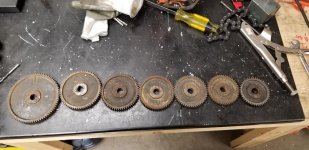Hi guys,
These are the gears I have, does anyone know if I am missing any? I have never cut threads before, and just starting my first threading project. I need to cut a short section of 1/4" 20 TPI threads. The manual says use a 32 on the stud and 80 on the lead screw? Do I have that right?
most of the gears have three numbers, not sure what that means - guessing different combinations. if anyone can point out a good how to on change gears it would be very appreciated.
thanks in advance.


These are the gears I have, does anyone know if I am missing any? I have never cut threads before, and just starting my first threading project. I need to cut a short section of 1/4" 20 TPI threads. The manual says use a 32 on the stud and 80 on the lead screw? Do I have that right?
most of the gears have three numbers, not sure what that means - guessing different combinations. if anyone can point out a good how to on change gears it would be very appreciated.
thanks in advance.






